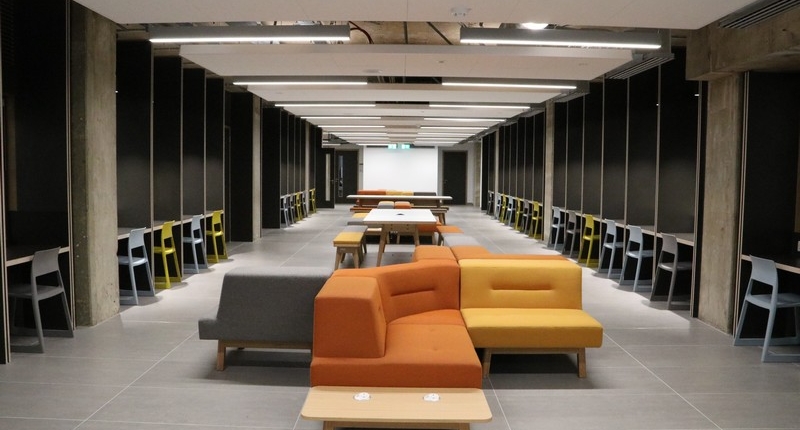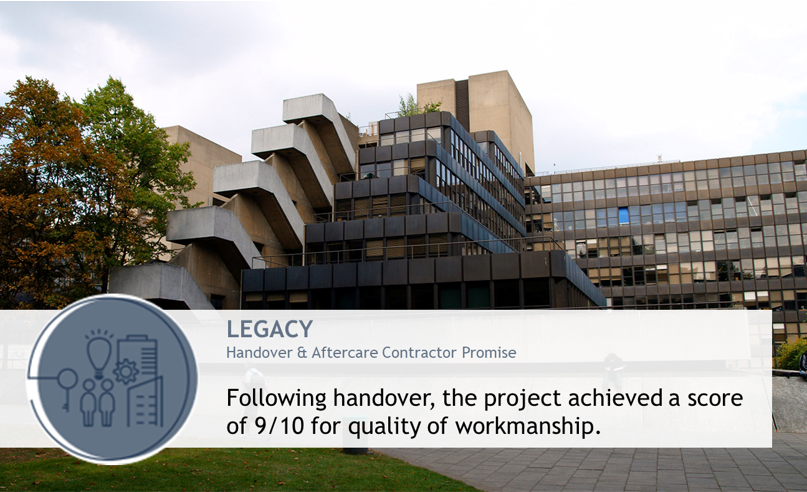Project Details
Client
UCL
Project Manager
Arcadis
Architect
Hawkins Brown (Concept) / Mace Design (Developed / detailed)
Contractor
Mace Limited
Value
£6.9m
Contract Period
43
Procurement Type
2 stage D&B with GMP
Form of Contract
JCT D&B 2016
Size
3152 sqm
Apprentices
110 training weeks on site
Project Summary
UCL appointed Mace via the Southern Construction Framework to undertake the partial refurbishment of the existing UCL (IoE) building located at 20 Bedford Way, Bloomsbury, London.
The project delivered the first phase of an overall masterplan for the building to refurbish and extend the building over the next few years. Due to UCLs campus wide restrictions on teaching space the building had to be maintained in full operation at all times.
The Phase 1 works comprised the alteration and refurbishment of existing storage and underutilised space to create 3,152sq m of teaching, study and breakout spaces. To create the space there was an initial programme of asbestos removal works prior to undertaking significant structural alterations together with the complete renewal of the MEP systems. External upgrades to windows and roofing was also included in the scope together with the formation of a new lift shaft. The project also catered for a temporary ‘pop-up’ student bar which had to be relocated as part of the works.
“The IOE forms part of UCL’s main Bloomsbury campus, giving students, researchers and partners access to UCL’s outstanding intellectual and cultural resources.”
‘The Mace team hit the project objectives and worked well with the team all despite a challenging set of site restrictions.’
Project Competencies
Fair
Fair Payment Charter
The close working relationship between UCL and Mace ensured payment was always made within 30 days.
Sustainable
Sustainable Development Charter
The site was CCS registered and exceeded the minimum 35/50 standard.
Safe
Health & Safety Charter
The site management team were fully SMSTS accredited, with a specialist liaison officer being appointed to manage contractor / student segregation in the ‘live’ working environment.
Legacy
Legacy Charter
The project employed wherever possible local labour, including 110 shared apprentice weeks.
Community Engagement
Career Opportunities
- 110 training weeks on site for apprentices through the project
Student Support
- The site team helped support the student union with the provision of a temporary bar and recreational facility with the provision of surplus materials and labour
Key Challenges
Noise Restrictions
Noisy working restrictions were imposed upon the works to ensure the university could maintain normal day to day operations.
Work activities were pre-planned with two week look ahead programmes being issued. This identified what works would be ‘noisy’ and these were planned within defined time slots which were agreed with the university. Generally these were first thing each morning, a period over lunchtime and then a final period at the end of the day. Maximum noise level criteria were set and the university had direct contact with the Mace team in the event of any issues.
Live Working Environment
The works had to be undertaken in a live working environment which meant that services had to be maintained to all areas at all times and students were not impacted by the works.
To prevent disruption to the day to day operation of the university, Mace structured a programme which created ‘swing space’ and where required ‘out of hours’ and weekend working. The use of ‘swing space’ allowed the works to be sub-phased enabling ‘live’ spaces to be moved and rotated thus enabling the alteration and refurbishment works to proceed. The ‘out of hours’ and weekend working were primarily used to ensure services infrastructure was maintained at all times. Typically these periods were used for services shut-downs or when works in occupied areas were required, for example the routing of services from existing plant space to the newly refurbished areas.
Approval Process
The existing building has Grade II* listed status which required all works to be fully approved by the planners and conservation officers from London Borough of Camden.
The Mace team worked closely with the Camden conservation team to ensure the works were undertaken sympathetically and achieved the required standards to comply with the building listing status. Schedules and trackers were prepared to monitored the works with samples and mock-ups being provided to ensure the finished works achieved the necessary statutory approvals.
Project Takeaways
Our Success
- Collaborative team working enabled the project to proceed smoothly with all parties being clear on roles and responsibilities. The positive team working built trust and enabled decisions to be made quickly and effectively to support the overall programme.
- The works produced a very good product which was arrived at by specifying good products, this together with the production of samples and mock-ups to ‘test’ what elements would look like and the gauge the level of quality. All of this supported the requirements to comply with listed building status.
- The collective team agreement to establish ‘swing-space’ supported the challenging programme delivery timescales. Without this the programme could not have been sub-phased which would have meant additional time being required in the overall delivery.
Our Learnings
- Limited time during preconstruction restricted surveys and preplanning activities. This led to level differences being discovered in the existing floor slabs. The net result being additional costs for screed and levelling. Cloud point surveys and Revit 3D modelling would overcome this going forward.
- The concept design was in some cases inaccurate and not representative of the actual site conditions. This created redesign work to ensure that what was drawn could actually be built. Early contractor engagement from RIBA Stage 2 would have overcome this problem.
- Despite all good plans there was on a few occasions some disruption to day to day operation of the university. Unfortunately the existing building fire alarm, whilst functional was time expired with little or no as built records. As a result this led to 2nr occasions of the alarm being triggered and the building evacuated. The scope included renewal of the fire alarm.
Value Added
- Mace were able to demonstrate added value benefits totalling £735k across the project. Early engagement enabled input into the masterplan which helped support the client with future plans for later phases. The client instigated £2.3m of change throughout the project, Mace were able to review the programme and sequence and incorporate the change into the project without extending the project end date.
KPI’s & Statistics
| Contract | Gateway 2 Planning | Gateway 3 Contract Agreement | Variation |
|---|---|---|---|
| Cost | £4,693,159.00 | £6,999,999.00 | 33% |
| Time | 35 weeks | 35 weeks | 0% |
Apprentices: 1nr for the full duration
CCS Score: 40/50
Waste diverted from landfill: 96%
Overall End User Service: 8/10
Contact: Martin Treacy, Capital Project Manager
Email: e.m.treacy@ucl.ac.uk









